
Dogs have played a critical role as human companions for thousands of years. Here, inside our Colonial Williamsburg Art Museums, we have a tour called A Dog’s Life that introduces visitors to various dog-related objects while explaining a dog’s place in society in early America. Let’s walk through the basics of the tour and give you a few extra fun facts about our canine friends!
Our tour starts at a painting titled, Eskimo Dogs, by Justin McCarthy, pictured at the top of this blog. It is a great portrayal of one way that humans use dogs to perform useful work—as sled dogs!
Recent research suggests that humans may have domesticated dogs twice, once in Asia and once in Europe, around 12,500 and 15,000 years ago respectively. They have since been specialized into more than 300 different breeds. With all of their various sizes, shapes, and personalities, dogs are part of our lives in a multitude of ways in the 21st century helping in the military, police force, hunting, the disabled, and as cozy companions on our couches.
Dogs in Colonial Williamsburg
Dogs were also important to people in the 18th century, including the inhabitants of Colonial Williamsburg! This century saw the advent of dogs as true “pets” in the home, with people first allowing dogs to sleep in the house and feeding them from the scraps off the family table. Williamsburg was home to so many dogs, that in 1772, city leaders passed the Act to Prevent Mischief by Dogs, which limited households to two male dogs, relegated females to the countryside and required all canines in town to wear dog collars. This law provided a convenient way to limit the town’s dog population—as physical separation was the only means of population control in a society where anesthesia was not used on people—let alone animals. Spaying and neutering was simply not an option in 18th-century Williamsburg.
Dog Objects in the Museum
People were so concerned about their dogs in colonial times that they often posted advertisements for lost or stolen ones in newspapers. There were even eulogies written for deceased dogs printed in colonial newspapers! One dog lover, most likely Philip Lightfoot II, commissioned a set of ten silver buttons depicting hunting dogs each of which has its own name. These buttons would have been worn on a hunting coat.
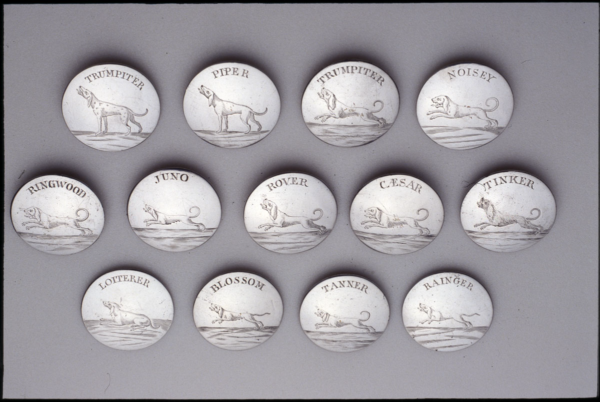 The buttons are on display in a textile drawer along with a printed handkerchief, a more egalitarian object, portraying a fox hunt in the English countryside with a hunting song printed along the border.
The buttons are on display in a textile drawer along with a printed handkerchief, a more egalitarian object, portraying a fox hunt in the English countryside with a hunting song printed along the border.
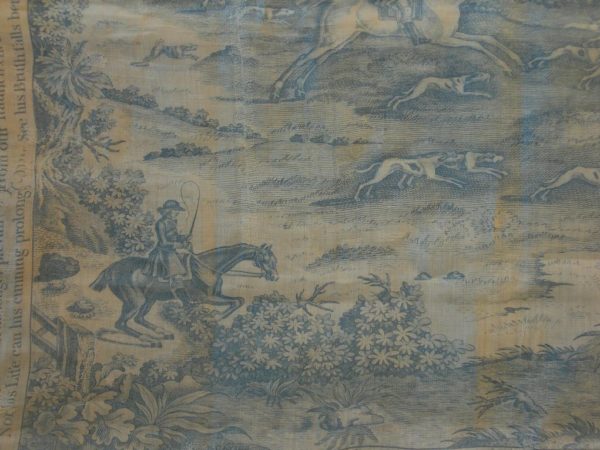
Colonial Dogs: Family to Some, Morally Dubious to Others
However, the perception of dogs as almost-family-members was certainly not as dogma (pun intended!) as it is today. In fact, there were competing philosophies concerning the moral status of dogs. Some people saw them as morally questionable since they ate the same food as their owners where there were people dying of starvation not far away.
Others, like famous painter William Hogarth, had no problem elevating their dogs to positions reminiscent of a human companion. Hogarth actually painted one of his three pugs, Trump, in the foreground of his self-portrait! We are lucky enough to have acquired one of only a handful of ceramic versions of Hogarth’s Trump here at the museum. The ceramic Trump, pictured below, is actually based off of a terra cotta original that Hogarth commissioned a French sculptor to make of his beloved pet.
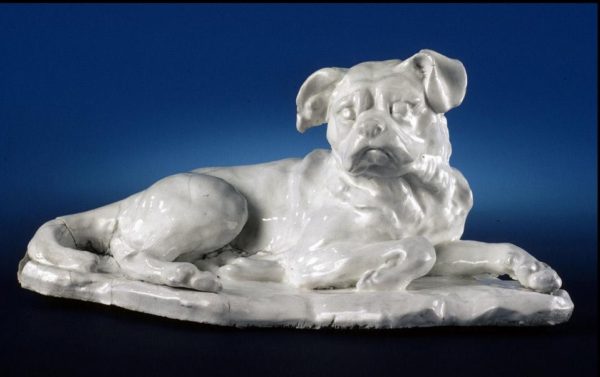
Clearly dogs had reached the status of beloved family member for some people in the 18th century, even if they had not evolved into the hundreds of breeds that now compete in 21st century dogs shows. We do know that dogs behaved pretty similarly in the 18th century as ours do today.
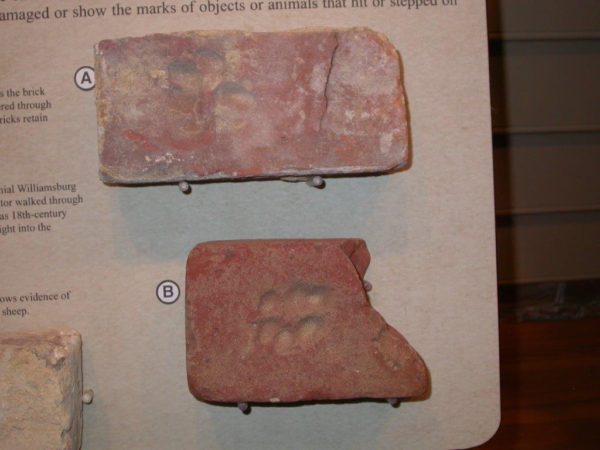
(Proof: we have two Williamsburg bricks: one from 1750 and one from 2009, both with dog footprints from when they had run through the brickyard while the bricks were still wet. Apparently mischievous dogs aren’t just around today!)
Please, stop by our next tour of A Dog’s Life and learn more about these objects in our collections. It takes place every Wednesday morning this summer from 10:30-11:15. On select days (it’s always a surprise to our staff too), we have a special visitor to end the fun—Liberty the Briard!
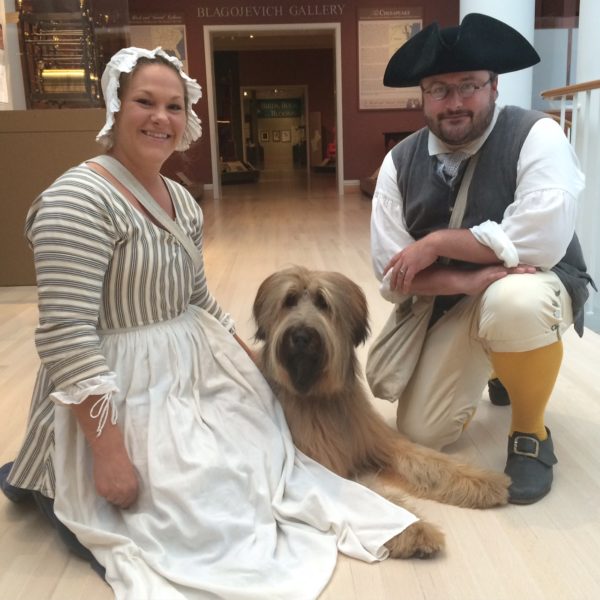
GUEST BLOGGER: EMMA MERRILL
 Emma is a recipient of the Woody Internship in Museum Studies, working for the Colonial Williamsburg Art Museums. She is also a rising junior at the College of William & Mary, just up the road! Emma is a double major in history and public policy and spends most of her free time swimming for the W&M Women’s swim team. Go Tribe!
Emma is a recipient of the Woody Internship in Museum Studies, working for the Colonial Williamsburg Art Museums. She is also a rising junior at the College of William & Mary, just up the road! Emma is a double major in history and public policy and spends most of her free time swimming for the W&M Women’s swim team. Go Tribe!
Emma is well known for her love of peanut butter, Nutella, and playing Pokémon GO on the way to work.
Very enjoyable article. Will have to take the tour!
What a very interesting article! I love the 1750 paw print in the brick!
Ok - I’m expecting equal time for cats, folks!
Great research on a topic close to a dog lovers heart!
Great description of a dog’s life during the Colonial times. I’m looking forward to visiting the museum during our next visit to Williamsburg.